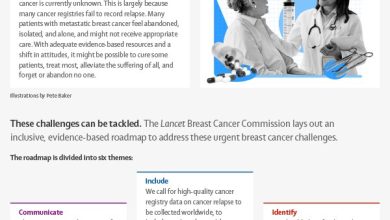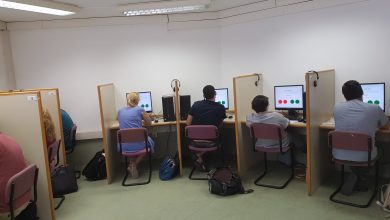
How to encourage healthy habits

Ask a teenager whether they’re eating healthy or getting enough exercise, and you might get a blank look.
With school getting more demanding, extracurricular activities multiplying, and college applications looming, teens have a lot going on. Many are also starting to work jobs, care for younger siblings, and take on other family duties—even amid drastic changes to their hormone levels and bodies, as well as their sense of who they are and their relationships with family and peers.
“It all comes together in a way that can be really wonderful, but also really overwhelming,” said Venus Kalami, N20, director of pediatric nutrition at the company Solid Starts, who has worked heavily with teens in her seven years of experience as a clinical dietitian.
Erin Hennessy, dean for research strategy and associate professor at the Friedman School of Nutrition Science and Policy at Tufts and director of the project ChildObesity180, agreed. “In the order of things that teens have to be concerned about, nutrition and exercise are low,” she said.
But as a public health concern, they’re high on the list. Whether they know it or not, most teens are not meeting the Dietary Guidelines for Americans in major ways, according to Christina Economos, dean of the Friedman School and founder of ChildObesity180.
They’re eating fewer fruits, vegetables, and whole grains, and more added sugars, saturated fat, and sodium than the guidelines advise. And only one in five adolescents are meeting the Center for Disease Control and Prevention’s guidelines for aerobic and muscle-strengthening activities (60 minutes of physical activity a day, 30 of them “vigorous”).
Due to demanding schedules and other factors, many teens find it difficult to eat regular meals and stay hydrated, Kalami said, which leads to lower energy levels and worse moods.
If not addressed, it can affect their health in the long run, too. Not building enough muscle and bone can lead to lower bone density in adulthood. Obesity in adolescence makes adult obesity almost 18 times more likely—and almost 30% of teens today have overweight or obesity, compared to 15% 60 years ago. On top of that, a record high 10% of U.S. households with children are food insecure, and rates of eating disorders among teens are on the rise. All this only got worse over the pandemic, with many parents out of work, teens stuck at home, and high levels of stress across the board.
But there are things that teens and the adults around them can do to promote healthier eating and more exercise, Tufts experts agreed—and there is reason for optimism, Hennessy added.
“Over the past few decades as we’ve seen an increase in obesity rates, we have also seen a shift in interest among children, teens, and young adults who are becoming much more interested in food, food justice, agriculture, the environment, and how those pieces are interconnected,” Hennessy said. “They’re coming to us at the Friedman School with far more understanding and knowledge about the field than I’ve ever seen, and it’s great to see that kind of shift and personal engagement with those topics.”
Challenges for teen nutrition and exercise
As children become teens, their energy and nutrient needs shoot up to an all-time high, because their bodies are growing. Particularly important for this growth are protein (for new tissue of all kinds), calcium and vitamin D (for bones), and iron, especially for those who are beginning to menstruate.
At the same time, teens’ schedules are getting busier, and their sleeping hours are shifting, leading to more barriers with eating regular meals and instead, leaning more on snacking. They are eating less at home, where parents might offer a healthy menu, and more with their friends or on their own–which leads to more fast food, processed snacks, soda, and sports drinks, especially at high schools with nearby convenience stores. “There’s a whole system that pushes the production, distribution, access, marketing, and palatability of unhealthy processed and ultra-processed foods,” Economos said.
Teens’ higher order executive functions such as impulse control and long-term thinking are still developing, making it tougher to make nutritious choices in a landscape already skewed toward unhealthy options. And with adolescence comes greater self-consciousness about one’s body and eating, more scrutiny and comparison on social media, and increasing levels of judgment from a society with unrealistic expectations about body size and weight—adding an extra level of stress, which drives emotional eating.
“There are growth spurts that cause their height and weight to shift in ways they haven’t experience before,” Hennessy said. “They can feel like their bodies are no longer in their control, which can cause stress and anxiety.”
More teenagers are also struggling with food allergies or intolerances, or medical conditions requiring dietary limitations—and the stress that comes along with them. “We can see a lot of over-restriction out of fear of accidentally ingesting something,” Kalami said. “And this may affect social life, hanging out with friends, participating in team sport events, and many domains of life.”
On the exercise side of things, Hennessy pointed out that research shows teens—particularly those who identify as girls—are less physically active than younger children. It helps to have access to team sports, exercise programs, or any physical activity opportunity and the support for engaging in these opportunities. But it also takes an environment—like having green space and neighborhoods safe to walk in—to also be physically active. Many teens from marginalized communities don’t have this type of access, she said.
And even parents’ most well-meaning efforts to improve teens’ eating and exercise can backfire. Studies show that an authoritarian parenting style, or one that’s high in control (lots of rules, restriction and controlling parental behaviors) and low in responsiveness (a lack of openness, warmth, support), is correlated with disordered eating symptoms in youths up to 18 years old, and high-risk behaviors such as substance abuse.
“Some younger adolescents are more comfortable with the rules and structure that their parents create and lay down,” Hennessy said, referring to the developmental psychology concept of the legitimacy of parental authority. “But older teens especially feel there are particular domain areas that their parents should not be making rules about, like who their friends are, or the ways they move their bodies, or what they ingest.” This can cause tension between parents and their teens.
Tips to promote better nutrition in teens
In light of these many factors, what can parents do to supporting teens in nourishing their bodies and finding forms of exercise that make sense for them? Tufts experts offered guidance ranging from being aware of specific nutrients, to including teens in food-related decision-making in the family.
Margie Skeer, interim chair of the public health and community medicine department at Tufts University School of Medicine, advised having regular family meals. Besides being linked to higher fruit and vegetable consumption and lower rates of disordered eating among adolescents, family meals have a protective effect against other high-risk behaviors, such as substance abuse.
It’s also essential to recognize the many forces in play beyond individual choice, and to approach nutrition and exercise as not solely the teen’s problem, but a function of the overall health of the teen’s family and the broader environmental context in which the family is situated, Hennessy said.
It’s essential to recognize the many forces in play beyond individual choice, and to approach nutrition and exercise as not the teen’s problem, but a function of the overall health of the teen’s family and environment, Hennessy said.
“How can we help teens develop a healthy relationship with food and movement, and create preferences that will carry them forward?” she asked. “How do we help create that foundation to return to throughout life for those who don’t have it, and how do we maintain it for those who do?”
Start with yourself. “How do I get my teen to go on a diet / exercise?” is a common online search phrase around teens and nutrition. But Hennessy suggested first stepping back and asking, “How am I role modeling healthy behaviors for my child?” and to shift the thinking from focusing on one child to thinking about the whole family and how the whole family can support and adopt healthy eating and movement behaviors.
Provide structure without being intrusive. Structure refers to the way parents organize their child’s environment to facilitate their child’s competence. What does that look like in practice? Setting rules and limits, providing limited or guiding choices, setting routines, role modeling, involving teens in food preparation and meal selection, and making healthy food available and accessible.
Know your teen’s nutritional needs. Consult a pediatrician or dietitian, Economos said, as well as resources such as the USDA’s MyPlate Nutrition Information for Teens. Pay special attention to whether your teen is getting enough dairy or plant-based dairy alternatives (for calcium and vitamin D), and iron sources such as red meat, beans, leafy greens, and fortified cereals.
Watch for changes and patterns. Rather than focusing on your teen’s size or weight, watch for new behaviors such as skipping meals, starting to eat much more or less, as well as higher stress levels around food, Hennessy said. Observe how often these behaviors repeat and provide support for your teen, and if there is ever a concern about certain behaviors, consult your health care provider.
Connect with your teen. Kalami has often asked about teenage clients’ passions and interests, which can provide the will and the ways to improve health. Skeer emphasized not just spending mealtimes with teens (ideally at least half of all meals), but making sure it’s quality time—meaning a relaxed, supportive environment with open communication and no distractions (such as phones). “Parents eating meals with teens conveys that spending time together is important to them,” Skeer said.
Empower your teen. Instead of prescribing healthy habits, learn your teen’s goals around eating–for example, being a vegetarian–and help them accomplish them in a healthy way, Hennessy said. Economos highlighted the importance of including kids in meal planning and preparation from a young age, teaching them culinary skills and healthy approaches to eating.
Look to local resources. Organizations like Girls on the Run can bring teenage girls together with supportive adults to walk, jog, and run in their neighborhoods, while local dance classes could introduce elements of culture and fun, Economos said. Teens can also get together to walk or train for a 5K, or take free online classes on yoga or strength training. “Goal setting as a group, and a structure where people care if you’re coming, can be really helpful,” Economos said.
Find one small change that works. Whether it’s swapping in nuts for potato chips, setting phone alarms to drink water, dancing to Zumba videos, or going to the park with a friend or family member, it’s the small, realistic changes that make a difference, Kalami said–and you can start with just one.
Support balance and variety. Encourage not just physical health, but overall “food-related quality of life,” said Kalami–especially among teens anxious about eating the wrong thing. “One of the main things I advocate for is minimizing unnecessary restriction, and loosening it up so we can get some flexibility, freedom, and variety back in our lives,” Kalami said.
Tips for vegetarian and vegan teens
- Contrary to popular belief, kids and teenagers can be vegetarians or vegans and still eat a healthy, complete diet that meets all their nutrient needs.
- Eating vegetarian or vegan does not automatically make for a healthy diet.
- Cow’s milk is not less healthy than plant-based milks, and can play an important role in a healthy diet if you’re vegetarian but not vegan.
- If you’re vegan, drink plant-based milks for calcium and vitamin D—particularly soy milk, which has high bioavailability of these nutrients.
- Eat high-protein plant-based foods, such as nuts, beans, and seeds—quinoa is a great high-protein alternative to rice or pasta. Read the ingredients before buying meat substitutes, which can be high in added sugars and sodium.
- Eat plant-based foods high in iron, such as beans and leafy greens. Try to consume vitamin C-rich foods (such as citrus fruits) at the same time to increase your iron absorption.
- If you’re vegetarian, consume eggs and dairy to meet your vitamin B12 needs. If you’re vegan, consume nutritional yeast or B12-fortified products such as plant-based milks or yogurts.
Tips for teens with food allergies and intolerances
- Get the facts. If you suspect you have a food allergy or intolerance, visit an allergist for a blood test, skin prick test, or oral food challenge to determine what foods cause what reactions. If you were diagnosed a long time ago, visit an allergist again and see what treatment options may be available to you.
- Don’t unnecessarily cut out foods. Over-restriction can also be problematic. If you can comfortably consume a food without having difficulties, keep doing so. Try not to cut out foods you don’t have reactions to.
- With food allergies, take precautions. Read food labels and learn to properly interpret them. Ask about ingredients and cross-contamination potential at restaurants. Get an EpiPen prescription and always carry one in your purse or backpack, in addition to any other allergy medications; make sure your family or friends know how to administer it if you can’t (and what you’re allergic to).
Tufts University
Citation:
On teens, nutrition, and exercise: How to encourage healthy habits (2024, April 10)
retrieved 10 April 2024
from https://medicalxpress.com/news/2024-04-teens-nutrition-healthy-habits.html
This document is subject to copyright. Apart from any fair dealing for the purpose of private study or research, no
part may be reproduced without the written permission. The content is provided for information purposes only.
Segue as Notícias da Comunidade PortalEnf e fica atualizado.(clica aqui)






